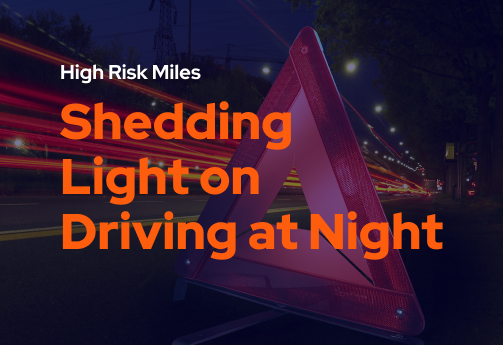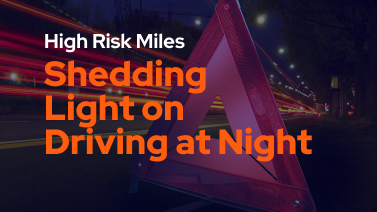High Risk Miles: Shedding light on driving at night

For many fleets, operating after dark isn’t optional — it’s part of the job. But those nighttime hours also carry a higher likelihood of accidents. At HDVI, we call this period High Risk Miles — the hours between 11:00 p.m. and 4:00 a.m. when crash rates peak across the industry.
Through HDVI’s Shift policy, fleets can track when and where risk increases, using real-time telematics data to make data-driven decisions about scheduling, safety, and driver performance. In this post, we’ll break down what makes night driving more dangerous, how to mitigate those risks, and how Shift can help fleets be smarter about the miles they drive.
What Are High Risk Miles?
As a Fleet Services and Risk Engineer, I help fleets understand Shift and the data that impacts their potential to receive discounts. The Shift metric I receive the most questions about is the latter; the High Risk Miles (When You Drive). High Risk Miles is defined as the time of day in which accidents are more likely to occur, which according to Shift data, are between 11:00 pm – 4:00 am.
HDVI’s Shift Policy tracks this information in real time using telematics, rewarding fleets that reduce their exposure to these riskier hours.
In short: Reducing high risk miles can lower the risk of being in a crash and provide potential insurance savings through HDVI Shift.
Why Night Driving Increases Risk for Commercial Truck Drivers
Driving at night presents unique challenges that can’t always be avoided in a 24/7 logistics world. But understanding the key risk factors is the first step in mitigating them.
1. Increased risk of fatigue-related crashes
According to the FMCSA, fatigue is a factor in roughly 13% of all large truck crashes, and the risk rises sharply between midnight and 6:00 a.m.
Even alert drivers experience slower reaction times and reduced judgment during these hours, as the body’s natural circadian rhythm promotes sleep.
2. Reduced visibility
Headlights only illuminate about 250–500 feet ahead, compared to miles of visibility in daylight. At 65 mph, a fully loaded truck can require over 500 feet to come to a complete stop — meaning your driver may not have enough time to react to unexpected hazards.
Nighttime also diminishes depth perception, color recognition, and peripheral vision, making defensive driving essential.
3. Greater exposure to impaired or drowsy drivers
Nighttime driving comes with an increased presence of impaired or fatigued motorists, particularly on weekends between midnight and 3:00 a.m. Commercial drivers must stay vigilant to protect themselves from others’ unsafe behavior.
4. Higher crash fatality rates
According to NHTSA, the fatality rate per vehicle mile traveled is three times higher at night. Although only about a quarter of all driving occurs after dark, nearly half of passenger-vehicle occupant fatalities happen during these hours — driven by fatigue, low visibility, and impairment.
How to mitigate night driving risk: Safety tips for fleets
While you can’t always control when your drivers are on the road, you can control how well they’re prepared. Here’s how to reduce night driving risk and keep your team safe.
1. Fatigue management
- Maintain a consistent sleep schedule to align with natural circadian rhythms.
- Encourage rest breaks every 2–3 hours and use short naps when needed.
- Avoid excessive caffeine — it’s not a substitute for quality sleep.
- Educate drivers to recognize early signs of fatigue before they become dangerous.
2. Adjust driving habits
- Reduce speed to account for limited visibility.
- Increase following distance to at least 6–7 seconds at night (per FMCSA).
- Stay alert for wildlife crossings, especially in rural or wooded areas during fall.
- Avoid unnecessary lane changes — predictability is key for night safety.
3. Stay alert to other drivers
- Watch for swerving or erratic vehicles that may indicate impairment.
- Keep a safe distance from vehicles that show inconsistent speeds or lane positioning.
- Report suspected impaired drivers when safe to do so.
4. Vehicle & driver readiness
- Keep headlights, taillights, and windshields clean for maximum visibility.
- Inspect both low-beam and high-beam functions before every shift.
- Dim dashboard lights to reduce glare and eye strain.
Apply reflective tape or markings to trailers for better nighttime visibility. - Encourage drivers to get regular vision checks —even slight vision impairments are amplified at night.
Taking control of high risk miles with HDVI Shift
HDVI’s Shift Policy is a dynamic pricing product that uses telematics data to analyze risk in real time. The system monitors three key components:
- How You Drive – Hard braking and high-speed miles
- Where You Drive – Highway and local miles
- When You Drive – High Risk Miles
At HDVI, we understand that night driving is part of keeping freight moving. The goal isn’t to eliminate high risk miles entirely — it’s to mitigate driving risk with the right data, training, and tools.
By combining proactive fleet management with HDVI’s telematics insights, fleets can turn risk into opportunity: safer operations, better driver performance, and real insurance savings.
Smart fleets don’t just manage risk — they measure it, learn from it, and improve it.
Ready to reduce risk and save with HDVI Shift?
High Risk Miles don’t have to mean high premiums. HDVI Shift rewards fleets that take safety seriously — using telematics data to drive performance, improve outcomes, and lower costs.
Learn more about HDVI Shift and how your fleet can mitigate risk and earn insurance discounts based on real-time driving data.


